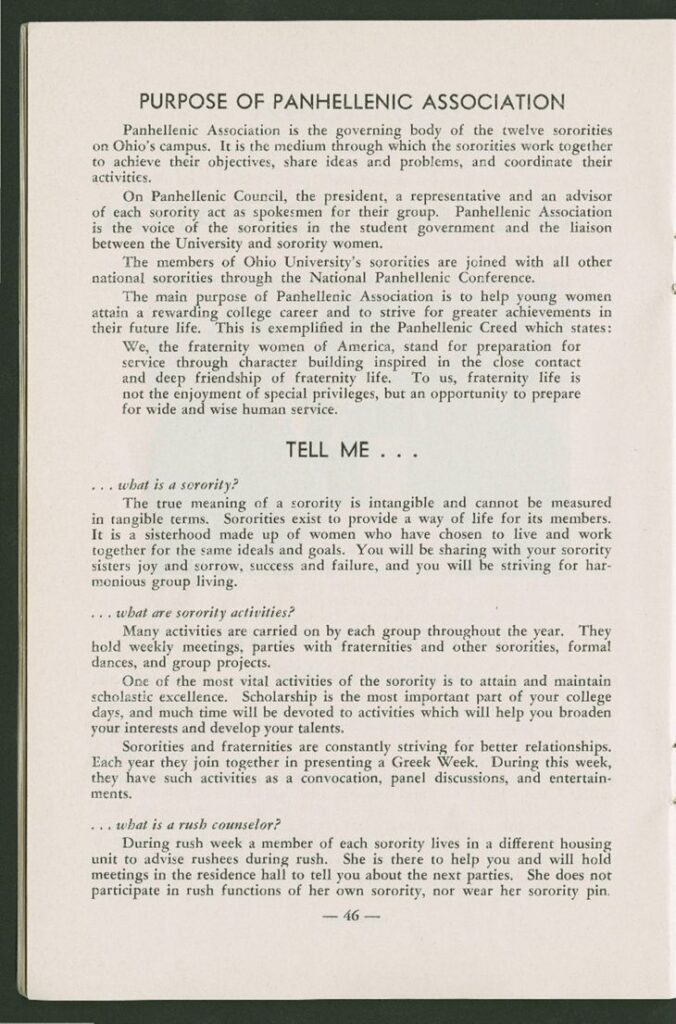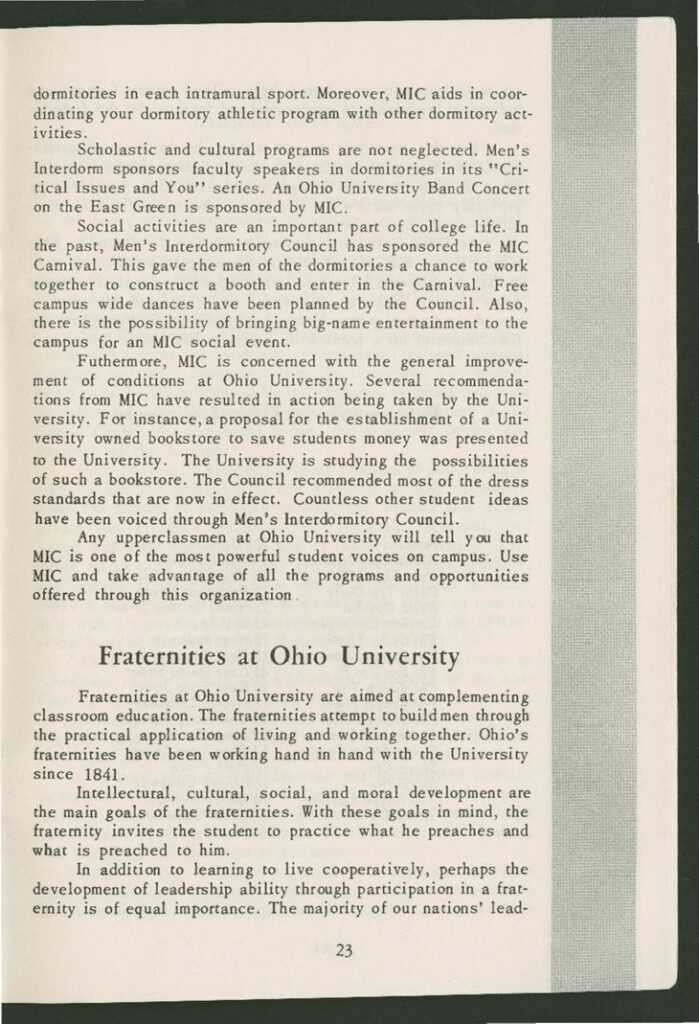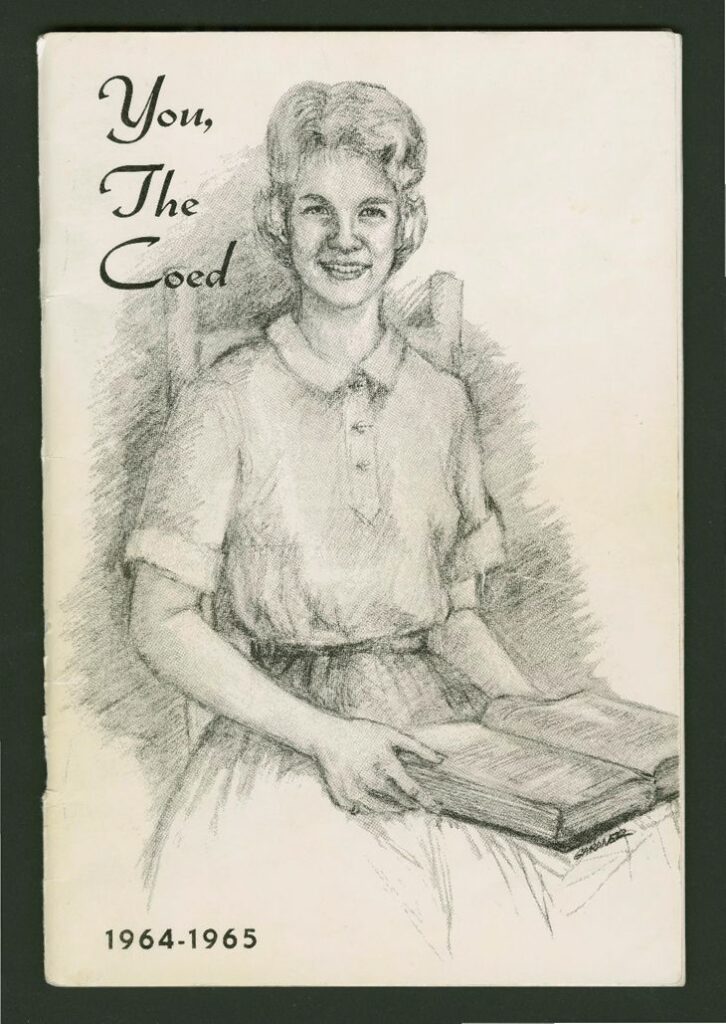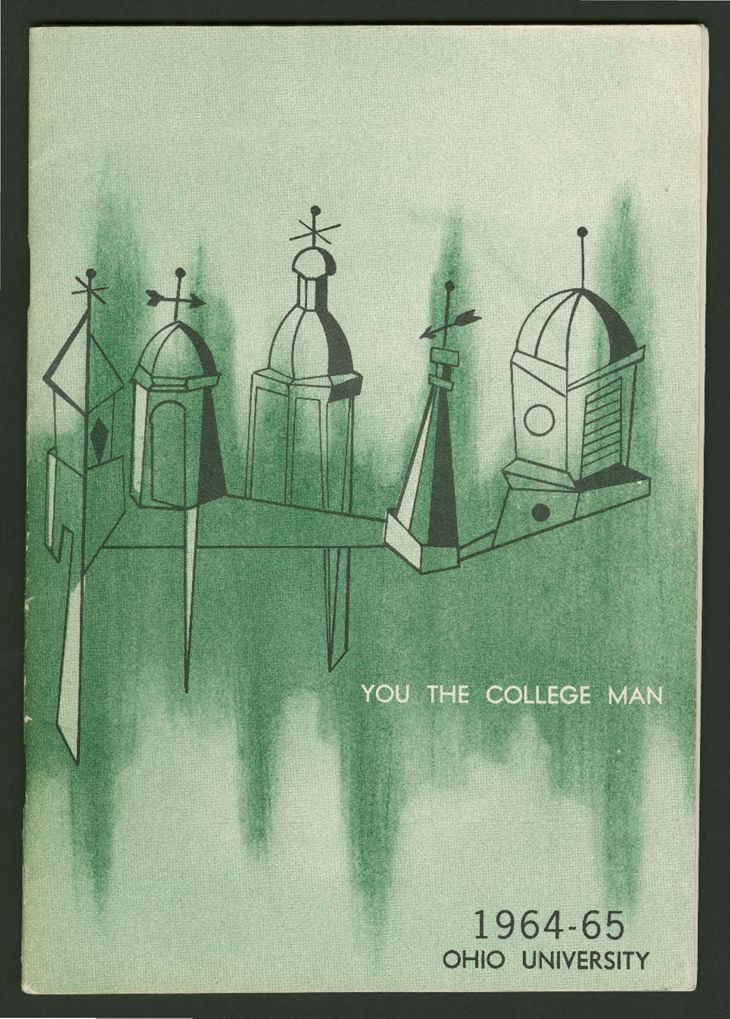Emma Fulton, Marketing and Analytics ‘26; Sydney Donohoo, Marketing ‘25; and Avery Tracz, Marketing ‘25, for JOUR 4130 Gender, Race, and Class in Journalism and Mass Media with Victoria LaPoe, Spring 2025
During the spring 2025 semester, the staff of the Mahn Center for Archives and Special Collections worked intensively with Victoria La Poe’s JOUR 4130 class, Gender, Race, and Class in Journalism and Mass Media. The students explored, selected, and researched materials from the collections, then worked in small groups to prepare presentations. The students had the option to then expand their research into a blog post like this one for their final project.
In the 1960s, female students at Ohio University had strict curfews, a demanding dress code, and extreme social standards. In fact, their handbook You, The Coed states that a woman should “be ready for dates” and “may offer her hand to a man if she desires” (You, The Coed, page 15). On the other hand, male students’ main expectation was to be studious. Today, we are accustomed to the idea that all students have equal opportunities, regardless of gender. Sixty years ago, however, women at the college were subordinate.
OU Maintaining Double Standards: Stereotyped Handbooks
In the 1960s, Ohio University placed strict rules on their students; the 1964-65 male student handbook You The College Man highlights the importance of being a strong, scholarly student. It covers topics like student services, academic standards, and residence hall life. In contrast, You, The Coed, the1964-65 female student handbook, tells female students the importance of social skills, Greek life, and dress code. Looking at the two handbooks side-by-side, it is apparent that OU enforced traditional gender roles, fitting with the cultural context of the 60s.
Notice the difference in how each handbook describes Greek life. For women, You, The Coed describes Greek life as a “way of life.” For men, You The College Man states fraternities are “aimed at complementing classroom education.”
You, The Coed focuses primarily on the salience of following social expectations. Women had stricter rules and social expectations, even regarding dating and lighting cigarettes. You, The College Man does mention these situations, but the framing of the two handbooks could not be any more different. While the 76-page women’s handbook describes how women should appear in society, the 29-page men’s handbook teaches men how to thrive in society.
“A college man is many things, but above all else, he is a scholar.” (You The College Man, page 10)
“The most important thing about being a college woman is being a lady.” (You, The Coed, page 13)
The handbooks not only instruct women how to act but, also tell women that they will only succeed by following the code that is laid out for them in their handbooks. In You, The Coed, strong rhetoric persuades women to uphold their standards, further enforcing society’s biases and stereotypes.
The covers of You, The Coed versus You The College Man. Notice how You, The Coed depicts a women sitting posed and dressed up, while You The College Man shows an illustration of the college.
Where Did the Double Standards Originate?
These double standards were not only present at OU. Individuals at the time were cultivated to believe that women had specific, inferior sex roles. Many grew up with the idea that women had to stay back and tend to the home, so they adopted and internalized these biased stereotypical ideals. Then, seeing how OU accepted these same ideologies, students in the 60s and 70s were primed to continue to believe in these double standards.
The unfair expectations of male versus female students were anti-progressive. The school did not push women to challenge themselves academically or socially. Standpoint theory suggests that individuals’ perceptions, knowledge, and beliefs are a result of their social position (“Encyclopedia”). In 1960s society, men expected women to listen and follow them; as a result, priming made women believe that they could not be powerful, educated leaders. Instead of studying economics or law, they met societal norms and succumbed to the biased ideologies of their time. Sixty years ago, women at the college were seen as lesser, presumed to fit the male gaze while studying female-“appropriate” subjects.
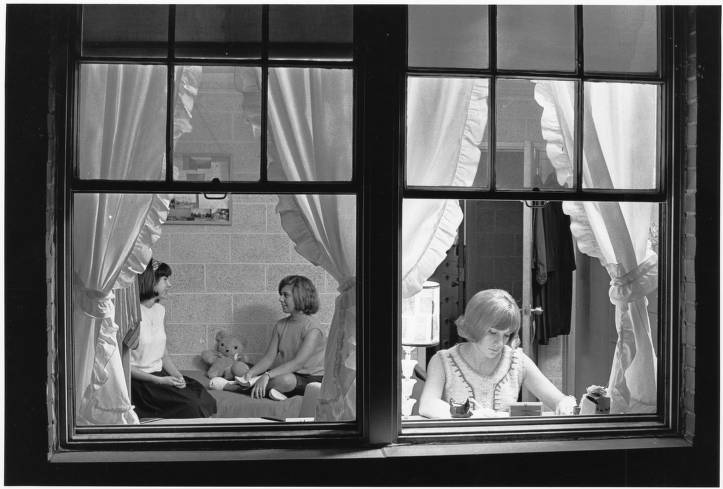
The Response to Double Standards
After so many years of low expectations and subjugation to these expectations, many female students at OU strived for change. One major issue for female students were their harsh curfews, which included being locked up in their residence halls before midnight except in special school function occasions. In response, in the late 1960s, 850 women participated in a midnight walkout in protest (Coward, 2018). This student activism eventually led to the curfew being abolished in 1971. This wave of the feminist movement brought a new sense of bravery and determination to women across the country, and it had positive consequences for women at OU.
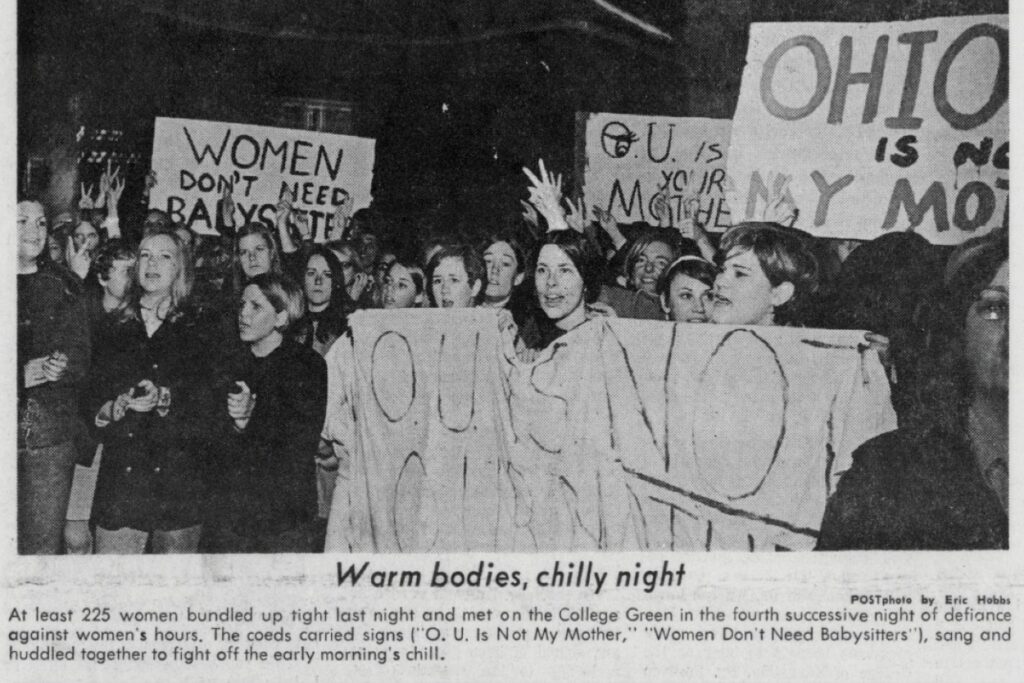
Years later, the passing of Title IX changed women’s college experiences, improving gender equality in college education. As a law, Title IX protects people from “discrimination based on sex in education programs” (“Title IX”). This law put an end to gender discrimination and double standards in many OU programs. For example, when Gene “Coach” Thrailkill took over the marching band in 1967, he banned women from the program. Excuses that Thrailkill offered for this at the time of the transition were the extra expenses of women’s uniforms, that he could work men harder, and that the esprit de corps would be greater with a male-only band (Post, May 1, 1967). However, in 1975, Director Ronald P. Socciarelli, finally yielded to OU administrative pressure to comply with Title IX, readmitted women to the 110 (Balmert, 2023).
After asking Bill Kimok–Ohio University Archivist–about this exclusion of women from the 110, he stated that banning “half of the population of the campus based on gender from actively participating in a university tradition that the other half of the population stood to benefit from” was “a big embarrassing backwards step.” After speaking with him, we as a group really learned how much of an impact this ban had on Ohio University’s culture and student body at the time.
Gender double standards also appeared in Ohio University’s sports programs. Men would receive far more scholarship for athletics than women, and the overall funding of the programs had a vast difference in the 60s and 70s. In fact, in 1970, Ohio University spent only $913 funding women’s athletics out of their total athletic budget of over $1 million (“Ohio University Budget”). Clearly, women were severely underrepresented in college athletics. Thanks to Title IX, however, these vast funding disparities have changed since then.
Because of these double standards, women at OU pushed for equality and representation in their academics, athletics, and college experiences. Surely, they succeeded. Today, women make up over 60 percent of OU’s student body and are some of the most resilient, dedicated students (“Diversity Dashboard”).
Possibilities for Future Research and Our Limitations
In addition to You The College Man and You, The Coed, the Ohio University Digital Archival Collections has a few handbooks for individual residence halls from years prior to 1960. Analyzing the language and framing of these handbooks in comparison to the ‘64-‘65 handbook would be a compelling research angle. The rhetoric of these books stands out to us, especially. Also, looking further into the gender biases within the Marching 110 under Thrailkill would provide students with ample history of our school and its extracurriculars.
Throughout our research, our main limitation was finding sources from the 1960s that analyzed these gender double standards at other colleges across the country. Our access to Ohio University’s digital archives was so helpful to our research, so as a group, we wished that there was unlimited access to the archives of other schools. This would show us the extent of the issue nationwide.
Sources
Balmert, J. (2023, October 2). A Century in the Making. OHIO Today. https://www.ohio.edu/news/2023/10/century-making
Coward, K. (2018, March 18). What guidelines women at OU had to follow in the ’60s. The Post. https://projects.thepostathens.com/SpecialProjects/the-womens-issue/double-take-womens-issue.html
Diversity Dashboard. Diversity Dashboard | Ohio University. (n.d.). https://www.ohio.edu/diversity/about/diversity-dashboard
Post (Athens, Ohio), May 1, 1967: Marching Band Goes All Male Ohio University Libraries Digital Archives Collection. https://media.library.ohio.edu/digital/collection/studentnewspapers/id/39759/rec/20
Emberton, K. (n.d.). Post (Athens, Ohio), October 12, 1967: All male marching band better in sound, spirit. Ohio University Libraries Digital Archival Collections. https://media.library.ohio.edu/digital/collection/studentnewspapers/id/40548/rec/4
Encyclopædia Britannica, inc. (n.d.). Standpoint theory. Encyclopædia Britannica. https://www.britannica.com/topic/standpoint-theory
Ohio University. (n.d.). Financial Report For the Fiscal Year Ended June 13, 1970. Athens, OH. Mahn Center for Archives and Special Collections.
Title IX and Sex Discrimination. U.S. Department of Education. (n.d.). https://www.ed.gov/laws-and-policy/civil-rights-laws/sex-discrimination/Title-IX-and-Sex-Discrimination
You the coed: A handbook for women students of Ohio University, Athens, Ohio, 1964-65. Ohio University Libraries Digital Archival Collections. (n.d.-a). https://media.library.ohio.edu/digital/collection/archives/id/42882/rec/17
You the college man, 1964-65: Handbook for the men of Ohio University. Ohio University Libraries Digital Archival Collections. (n.d.). https://media.library.ohio.edu/digital/collection/archives/id/42845/rec/1
